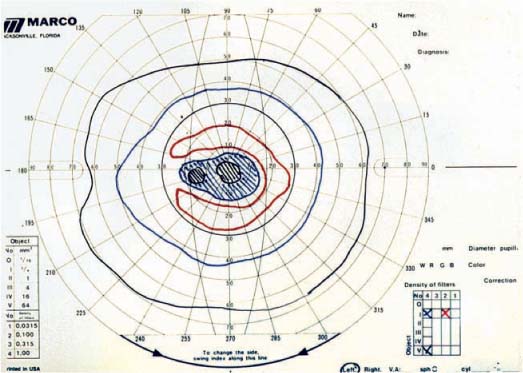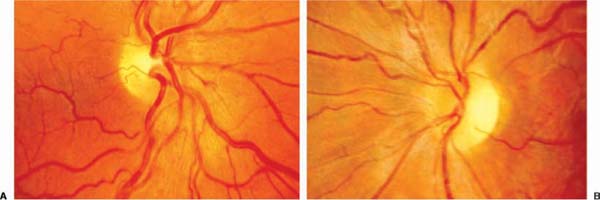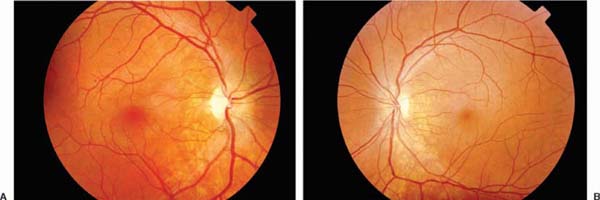Chapter 24 Hereditary optic neuropathy generally presents in one of three ways: (1) acute or subacute loss of vision (e.g., Leber’s hereditary optic neuropathy); (2) optic atrophy noted on routine exam with or without decreased visual acuity (usually dominant optic atrophy of Kjer); or (3) optic atrophy noted in the evaluation of an infant or child with apparent decreased vision. Knowledge of positive family history for hereditary optic neuropathies guides the diagnostic evaluation of patients with optic nerve disease. However, consideration should be given to other possibly treatable etiologies and appropriate workup completed prior to making a final diagnosis. LHON is an hereditary optic neuropathy, maternally inherited, associated with three primary mitochondrial DNA mutations (nucleotide positions 11778, 14484, and 3460).1 The disease is passed from mother to child and the carrier state to daughter. Any young person with acute vision loss should be evaluated by an ophthalmologist within 24 hours. Many patients with LHON report a more subacute pattern, which should be evaluated within several days. LHON occurs most frequently in males (male-to-female ratio in the United States is 9:1)2 and usually presents in the second and third decades of life. In many cases there is no family history of visual loss. Subacute, progressive, painless loss of central vision, usually monocular, over weeks is the classic pattern for LHON. Sequential vision loss in the fellow eye follows within weeks to months of the first eye. Visual loss is usually permanent, although occasional patients may demonstrate some recovery of vision years after the initial loss, most commonly in patients with the 14484 mutation. There is usually no pain associated with LHON. Visual acuity declines progressively to 20/200 or worse, usually bilaterally symmetric by the time the process is complete. Marked asymmetry and milder vision loss can occur, but is not the usual pattern. The classic defect is a dense central/cecocentral scotoma, often with extension superiorly and marked color vision loss (Fig. 24–1). A relative afferent pupillary defect is present with monocular or asymmetric bilateral disease. This usually becomes less apparent as the optic nerves become more symmetrically impaired. During the acute phase of visual loss, the fundus has a characteristic appearance (Fig. 24–2): FIGURE 24–1 Classic cecocentral visual field defect of Leber’s hereditary optic neuropathy. • Papillary and peripapillary telangiectasias • Thickened milky appearance of juxtapapillary nerve fiber layer (pseudoedema) • Although there is an elevated disc, a fluorescein angiogram will not demonstrate leakage at the disc. With time, the acute signs resolve, and optic atrophy ensues (Fig. 24–3). Some patients may have a multiple sclerosis like syndrome. The following features should raise the question of an alternate diagnosis: FIGURE 24–2 A,B: Acute optic disc changes in Leber’s hereditary optic neuropathy. The swelling is actually pseudoedema because as it does not leak with fluorescein angiography. FIGURE 24–3 A,B: Chronic optic disc changes in Leber’s hereditary optic neuropathy. Note the dramatic dropout of nerve fiber layer in papillomacular bundle and subsequent focal disc pallor. Occasionally patients with LHON present without classic demographic and funduscopic features. In these cases, the broad differential diagnosis of optic neuropathy in general must be considered. Acute presentation may resemble LHON, but patients with optic neuritis usually have pain with eye movement and begin to recover vision within several weeks.
HEREDITARY OPTIC NEUROPATHIES
LEBER’S HEREDITARY OPTIC NEUROPATHY (LHON)
URGENCY OF EVALUATION
DIAGNOSIS
Symptoms
Demographics
Visual Loss
Pain
Signs
Visual Acuity
Visual Field
Pupils
Optic Disc
Associated Abnormalities
Red Flags
 Evidence of intraocular inflammation, suggesting inflammatory or infectious optic neuritis or uveitis with associated optic neuropathy
Evidence of intraocular inflammation, suggesting inflammatory or infectious optic neuritis or uveitis with associated optic neuropathy
 Other neurologic signs and symptoms (headache, ataxia, cranial nerve palsy), suggesting an intracranial process
Other neurologic signs and symptoms (headache, ataxia, cranial nerve palsy), suggesting an intracranial process
 Bilateral simultaneous vision loss or loss in fellow eye within 24 to 72 hours, suggesting optic neuritis
Bilateral simultaneous vision loss or loss in fellow eye within 24 to 72 hours, suggesting optic neuritis
 Bitemporal or junctional visual field pattern (cecocentral defect in one eye and temporal defect in fellow eye), suggesting a chiasmal process, most likely compressive or inflammatory (see Chapter 7)
Bitemporal or junctional visual field pattern (cecocentral defect in one eye and temporal defect in fellow eye), suggesting a chiasmal process, most likely compressive or inflammatory (see Chapter 7)
 Periorbital pain suggests orbital inflammation or optic neuritis
Periorbital pain suggests orbital inflammation or optic neuritis
 Lack of confirmation on genetic testing (see later)
Lack of confirmation on genetic testing (see later)
Differential Diagnosis
Optic Neuritis (Idiopathic) (see Chapter 20)
Stay updated, free articles. Join our Telegram channel

Full access? Get Clinical Tree





